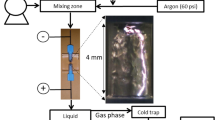Abstract
The catalytic effect of iron wires on plasma syntheses of ammonia and hydrazine has been studied in the nitrogen-hydrogen plasma prepared using rf discharge at a pressure of 650 Pa (5 Torr). The product was mainly ammonia including a small amount of hydrazine. When iron wires were placed in the plasma downstream of the gas flow, the yields of both products increased, about two times in ammonia and two orders of magnitude in hydrazine. The yields increased with increasing number of wires (the surface area of the catalyst). The dissociative adsorption of nitrogen molecules and/or molecular ions on the iron surface and the formation of NHx by the reaction with hydrogen in the plasma followed by the formation of NH3 or N2H4 are considered as a reaction scheme. This is supported by the identification of NH3 with XPS of the surface of iron wires.
Similar content being viewed by others
References
M. Venugopalan and S. Veprek,Top. Curr. Chem. 107, 1 (1983).
K. S. Yin and M. Venugopalan,Plasma Chem. Plasma Process. 3, 343 (1983).
M. Venugopalan,Nucl. Instrum. Methods B 23, 405 (1987).
G. Y. Botchway and M. Venugopalan,. Phvs. Chem., Neue Folge,120, 103 (1980).
E. N. Eremin,Russ. J. Phys. Chem. 49, 1113 (1975).
M. Konuma, Y. Kanzaki, and O. Matsumoto,Denki Kagaku 47, 597 (1979).
O. Matsumoto, S. Yakura, and Y. Kanzaki,Denki Kagaku 50, 189 (1982).
H. Uyama and O. Matsumoto,Plasma Chem. Plasma Process. 9, 13 (1989).
H. Uyama, M. Matsunaga, and O. Matsumoto,Nippon Kagaku Kaishi, 880 (1989).
G. Ertl and N. Tyiele,Appl. Surf. Sci. 3, 99 (1979).
G. Ertl,Stud. Surf. Sci. Catal. 44, 315 (1989).
A. Szabo and H. Wilhelmi,Plasma Chem. Plasma Process. 4, 89 (1984).
O. Matsumoto, M. Konuma, and Y. Kanzaki,J. Less-Common Met. 84, 157 (1982).
L. Schott, inReactions under Plasma Conditions, M. Venugopalan, ed., Wiley-Interscience, New York (1971), p. 515.
J. L. Vossen,J. Electrochem. Soc. 126, 319 (1979).
S. Kimura, E. Murakami, K. Miyake, T. Warabisako, H. Sunami, and T. Tokuyama,J. Electrochem. Soc. 132, 1460 (1985).
V. L. Syaduk and E. N. Eremin,Russ. J. Phys. Chem. 49, 310 (1975).
S. N. Foner and R. L. Hudson,J. Chem. Phys. 45, 40 (1966).
V. L. Syaduk and E. N. Eremin,Russ. J. Phys. Chem. 46, 1644 (1972).
K. Miyahara,Chem. Left., 1871 (1983).
S. Veprek,Pure Appl. Chem. 48, 163 (1976).
Author information
Authors and Affiliations
Rights and permissions
About this article
Cite this article
Uyama, H., Nakamura, T., Tanaka, S. et al. Catalytic effect of iron wires on the syntheses of ammonia and hydrazine in a radio-frequency discharge. Plasma Chem Plasma Process 13, 117–131 (1993). https://doi.org/10.1007/BF01447174
Received:
Revised:
Issue Date:
DOI: https://doi.org/10.1007/BF01447174




